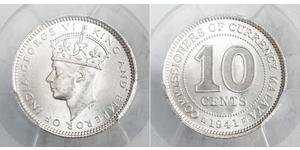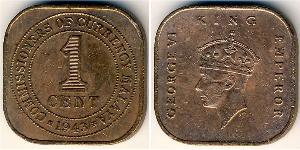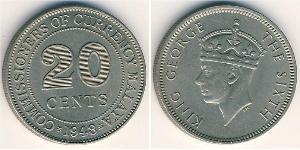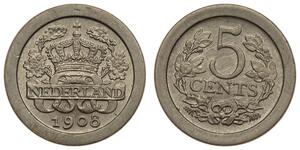10 Cent
1941, British Malaya, George VI. Silver 10 Cents Coin. Low Pop 27/3! PCGS MS65!
Mint Year: 1941
Reference: KM-2.
Denomination: 10 Cents
Mint place: Kremnitz (KB)
Condition: Certified and graded by PCGS as MS-65! - Population 27/3!
Material: Silver (.750)
Diameter: 18mm
Weight: 2.71gm
 The term "British Malaya" (/məˈleɪə/; Malay: Tanah Melayu British) loosely describes a set of states on the Malay Peninsula and the island of Singapore that were brought under British hegemony or control between the late 18th and the mid-20th century. Unlike the term "British India", which excludes the Indian princely states, British Malaya is often used to refer to the Federated and the Unfederated Malay States, which were British protectorates with their own local rulers, as well as the Straits Settlements, which were under the sovereignty and direct rule of the British Crown, after a period of control by the East India Company.
The term "British Malaya" (/məˈleɪə/; Malay: Tanah Melayu British) loosely describes a set of states on the Malay Peninsula and the island of Singapore that were brought under British hegemony or control between the late 18th and the mid-20th century. Unlike the term "British India", which excludes the Indian princely states, British Malaya is often used to refer to the Federated and the Unfederated Malay States, which were British protectorates with their own local rulers, as well as the Straits Settlements, which were under the sovereignty and direct rule of the British Crown, after a period of control by the East India Company.
Before the formation of the Malayan Union in 1946, the territories were not placed under a single unified administration, with the exception of the immediate post-war period when a British military officer became the temporary administrator of Malaya. Instead, British Malaya comprised the Straits Settlements, the Federated Malay States, and the Unfederated Malay States. Under British hegemony, Malaya was one of the most profitable territories of the Empire, being the world's largest producer of tin and later rubber. During the Second World War, Japan ruled a part of Malaya as a single unit from Singapore.
The Malayan Union was unpopular and in 1948 was dissolved and replaced by the Federation of Malaya, which became fully independent on 31 August 1957. On 16 September 1963, the federation, along with North Borneo (Sabah), Sarawak, and Singapore, formed the larger federation of Malaysia.

|
发布人:
anonymous 2023-10-30 |
|
||
|
||
|
||
|
||
|
||
 English
English
5 Cent 荷兰
本组有 11 钱币 / 8 售价
⇑

















